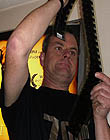|
|
This topic comprises 2 pages: 1 2
|
|
Author
|
Topic: IMAX platter/threading question
|
Thomas Pitt
Master Film Handler

Posts: 266
From: Leeds, West Yorkshire, UK
Registered: May 2007
|
 posted 03-02-2008 03:44 PM
posted 03-02-2008 03:44 PM




A few days ago, I visited the Bradford IMAX and saw Lions 3D. Afterwards I went up to the projection booth viewing area and watched the projectionist change over the platters for the next film. While watching, I noticed a couple of differences in the way the platters and projectors are threaded up as opposed to 35mm.
Firstly, instead of putting the very beginning of the leader through the brain and feeding it as necessary, the projectionist wound the leader around his hand 15-20 times. Then he threaded the brain, leaving a mini-reel of leader ahead of it. Afterwards, he took that mini-reel all the way over to the projector, slowly taking up more film from the platter as he threaded the rollers and projector.
After threading, the mini-reel was taken back over to the platter via the rollers and attached to the takeup ring - the excess leader being manually unwound round the takeup ring on the platter.
My question is, what is the advantage in doing it this way? Why not thread the very beginning of the film through the brain, rollers and projector - taking up more film from the platter as necessary? I have a suspicion it may have something to do with the start frame on the reel, but surely the projector could be manually advanced until the start frame is in position?
| IP: Logged
|
|
|
|
|
|
|
|
|
|
|
|
|
|
|
|
Thomas Pitt
Master Film Handler

Posts: 266
From: Leeds, West Yorkshire, UK
Registered: May 2007
|
 posted 03-03-2008 03:36 PM
posted 03-03-2008 03:36 PM




quote:
Spooling up the film until just before the Picture Start area makes the most sense, and yes, the film never hits the floor!
Actually, it DOES hit the floor ![[Frown]](frown.gif)
Once the automation stops, the projectionist presses a button on the console that makes the projectors slowly advance, until the tail of the junk footer is pulled off the platter and hits the floor. Once it's free of the platter rollers, the projectionist can open the IMAX hood and un-thread the film, before spinning the takeup platter by hand to get everything back onto it.
Just out of interest, why not un-thread the projector by simply allowing the film to tail out through the projector, like with many 35mm systems?
Incidentally, the Bradford IMAX uses dual SR projectors, not the single GT projector.
| IP: Logged
|
|
|
|
|
|
|
|
Tristan Lane
Master Film Handler
Posts: 444
From: Nampa, Idaho
Registered: Feb 2002
|
 posted 03-05-2008 02:16 AM
posted 03-05-2008 02:16 AM




Agreed on tail out. Since the input sprocket maintains the slack loop within the rotor, when the tail of the film leaves the input sprocket, the loop is lost and the output sprocket just pulls the film regardless of whether there is a loop present. The cam pins or registration pins usually end up destroying the film. If the cam takes the brunt of the pull, it can mess up the timing.
On the threading: I've done it both ways. I've been to a number of SR / QTRU sites that were threaded in a typical 35mm fashion, where the leader is pulled through the brain and the projector is threaded after the takeup platter has been wound. The leader never touched the floor, but it did get drug around the front housing of the projecotor.
On MK2 feed units, this was impossible since the centerfeed unit was not present, and the response of the feed control was not quick enough to compensate for the start-stop nature of pulling the film as needed. The "twiddle" method shown in the video was the only acceptable method on MK1 an MK2 installations, even though the old classic 2D projectors had rollers that were installed outside of the normal film path to accommodate unthreading the projector without dragging the film on the floor. I always thought that if a QTRU was used, threading could be accomplished in much the same manner as 35mm since those extra rollers were there.
| IP: Logged
|
|
|
|
|
|
|
|
All times are Central (GMT -6:00)
|
This topic comprises 2 pages: 1 2
|
Powered by Infopop Corporation
UBB.classicTM
6.3.1.2
The Film-Tech Forums are designed for various members related to the cinema industry to express their opinions, viewpoints and testimonials on various products, services and events based upon speculation, personal knowledge and factual information through use, therefore all views represented here allow no liability upon the publishers of this web site and the owners of said views assume no liability for any ill will resulting from these postings. The posts made here are for educational as well as entertainment purposes and as such anyone viewing this portion of the website must accept these views as statements of the author of that opinion
and agrees to release the authors from any and all liability.
|

 Home
Home
 Products
Products
 Store
Store
 Forum
Forum
 Warehouse
Warehouse
 Contact Us
Contact Us




 Printer-friendly view of this topic
Printer-friendly view of this topic












![[thumbsup]](graemlins/thumbsup.gif)
![[Frown]](frown.gif)






